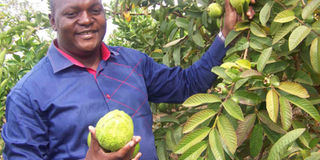Best practices of post-harvest handling

A farmer harvests fresh guavas in Mityana File photo
Horticulture farming is an important and increasingly becoming reliable source of foreign exchange earnings for the country.
The export earnings from the horticultural sector have been growing spectacularly over the years.
The country has a relatively low market share for almost all horticultural products and therefore, has an opportunity for rapid growth from potential buyers both within the country and elsewhere.
This can only be possible if farmers engaged in growing these crops are in position to observe the best practices possible right from production to post harvest handling.
As such there is concerted effort by scientists across Africa in collaboration with Korea Africa Food and Agriculture Cooperation Initiative (KAFACI) in trying to address challenges faced by farmers and those involved in the value chain on how to handle horticulture produce at post-harvest stage.
The five year project worth $800 million (about Shs3.1 trillion) to be shared among 15 African countries including Uganda, will be implemented by the National Crops Resources Research Institute (NaCRRI).
During the overview of the initiative by member countries in Kampala, the Korean deputy Chief of Missions, Lee Junhlee, explained that there is a huge challenge in African countries arising from post-harvest handling in the horticulture sector causing loss of revenue and food insecurity.
It is the reason the Korean government is dedicating its effort in sensitising farmers engaged in growing these crops in a bid to raise handling standards and compete favourably in the international market.
Each country has chosen modal crops and for the case of Uganda these practices will be demonstrated in handling of tomatoes and mangoes. The Director General of Naro, Dr Ambrose Agona explained that it is time for farmers growing horticulture crops to do it for commercialisation and this can only be possible if best practices are observed.
Pre-cooling after harvest
Field heat is usually high and undesirable at harvesting stage of many fruits and vegetables and should be removed as quickly as possible before any post-harvest handling activity.
Excessive field heat gives rise to an undesirable increase in metabolic activity and immediate cooling after harvest is therefore important. This reduces effects of microbial activity and reduces the ripening state.
The suitable temperature range of about 13 to 20°C for tomato handling can be attained either in the early hours of the morning or late in the evening.
Farmers can do this by dipping fruits in cold water mixed with disinfectants such as thiabendazole and sodium hypochlorite if available. The fruits should be assembled under a tree shed to reduce field heat.
Cleaning and disinfecting
Proper hygiene is a major concern to all produce handlers, because of not only postharvest diseases, but also incidence of food-borne illnesses that can be transmitted to consumers.
The use of various disinfectants during postharvest treatment of tomatoes and mangoes must be observed. For instance, sodium hypochlorite solution has to be used to sterilise fruits in order to reduce the incidence of fungal infection before any postharvest treatment is applied.
Fruits and vegetables should be treated with chlorinated water after washing to reduce the microbial load prior to packaging.
Sorting and grading
One of the most important processes in packaging and marketing of fruit and vegetables is sorting and grading. Sorting can be done by removing rotten, damaged, or diseased fruits from the healthy and clean ones.
The damaged or diseased fruits can produce ethylene in substantial amounts which can affect the adjacent fruits. Grading is done by categorising fruits and vegetables on the basis of colour, size, stage of maturity, or degree of ripening.
Storage
Tomato and mangos have very high moisture content and therefore are very difficult to store at ambient temperatures for a long time. It is important to store in a cool condition of 10–15°C where there is enough aeration.
Refrigeration storage is one of the most effective methods of preserving the quality of many fruits and vegetables for several days of about 30 – 50 days.
Transportation
The production sites for many fruit and vegetable producers are far from the marketing centres and also inaccessible by road.
The recommended means of transport is refrigerated trucks which is not only convenient, but also effective in preserving the quality of fruits. Alternatively small trucks can be used to transport the produce when they are still fresh.
Statistics
Dr Kephas Nowakunda head of Food Biosciences and Agricultural Research at the National Agricultural Research Laboratories in Kawanda giving statistical data about food waste and food loss noted that the figure of food loss in Africa is between 30 to 40 per cent annually. The loss in horticulture is estimated to be 15 per cent out of annual total production.
Packaging
Packaging is also one of the important aspects to consider in addressing post-harvest losses in fruits and vegetables. It is enclosing food produce to protect it from injuries, tampering and contamination from physical, chemical, and biological sources.
Some common packaging materials used include wooden crates, cardboard boxes, woven palm baskets, plastic crates, sisal sacks and jute sacks. Modified atmosphere packaging which is a new packaging technique is encouraged because it contains gases such as oxygen and carbon dioxide good to preserve the products.
Harvesting
The physiological maturity of any fruit at harvest has an important effect on postharvest quality of that fruit.
Therefore, care must be taken as to when to harvest the fruit in order to attain the best quality.
They must be partially ripe preferably when still green but in mature state for farmers to start harvesting.
The use of harvesting and packaging containers with sharp edges must be discouraged to prevent bruising and puncturing of the fruits.
Harvesting of fruits should be done in either early or late hours of the day to avoid excessive field heat generation.
Avoid practices for the fruits to perish in a short period of time because access to ready market such a product will be a big challenge.




